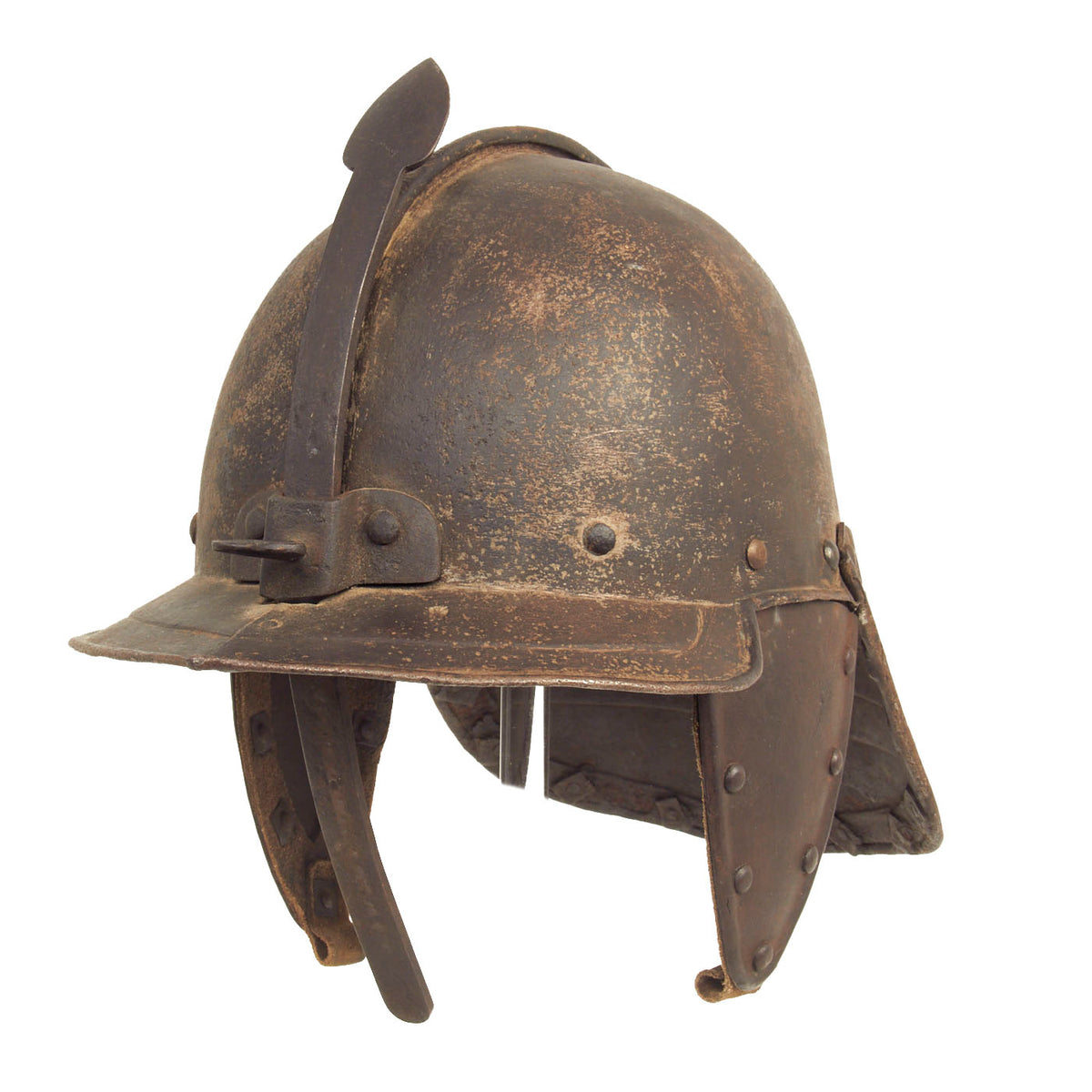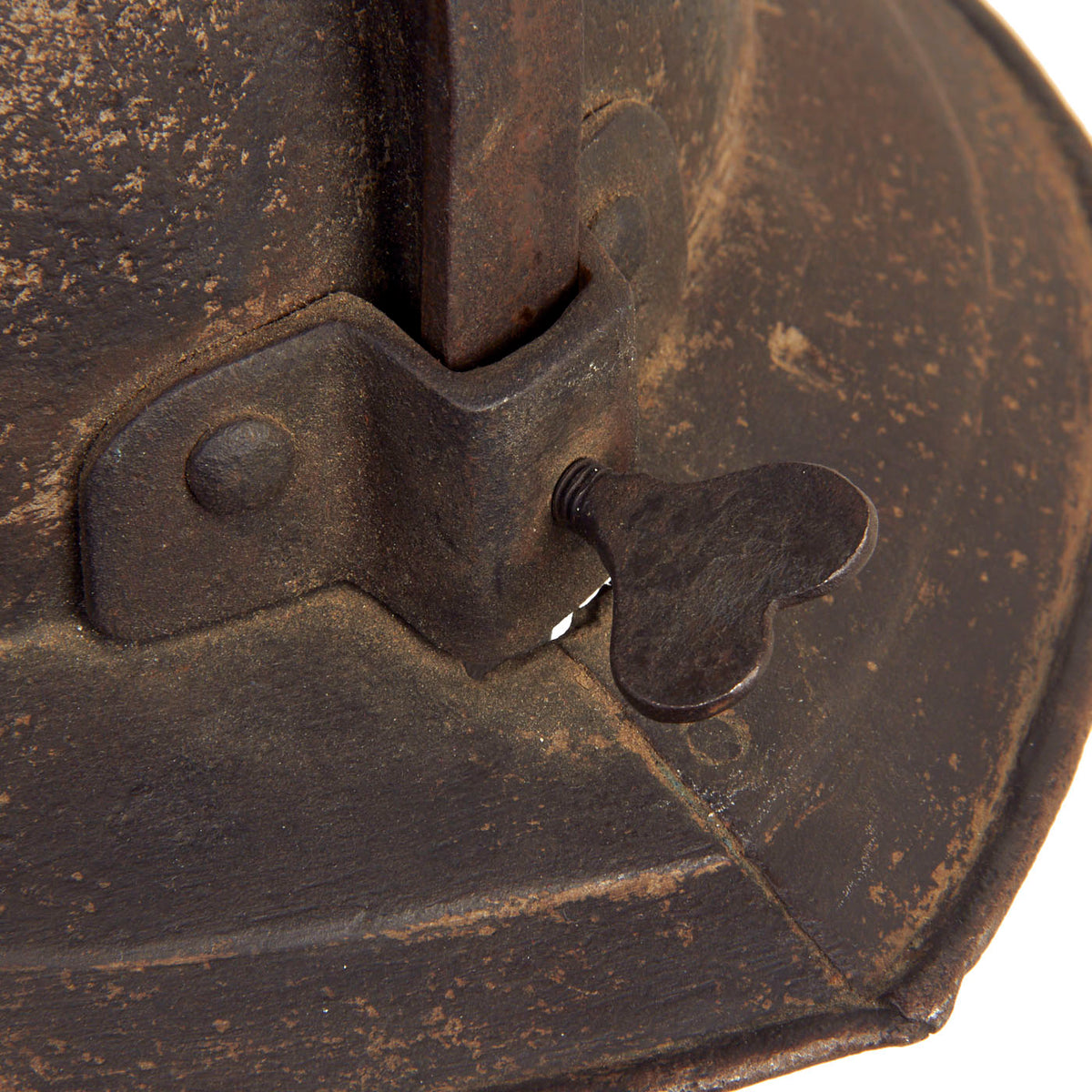Original British 17th Century English Civil War Harquebusier Lobstertail Helmet – Circa 1640 Original Items
$ 2.895,00 $ 723,75
Original Items: Only One Set Available. Now this is a fantastic armor grouping! This armor dates back to the 17th during the The English Civil War (1642–1651). The war was a series of civil wars and political machinations between Parliamentarians (“Roundheads”) and Royalists (“Cavaliers”), mainly over the manner of England’s governance and issues of religious freedom.
The harquebusier would usually be armed with a wheellock, snaphaunce or doglock flintlock carbine hung from a swivel attached to a baldric, pistols in saddle holsters, and a stout, straight-bladed sword. The ‘dog’ of the doglock was a type of safety-catch used to prevent the unintentional firing of the carbine when on horseback. Records also indicate that some harquebusiers were also armed with a horseman’s poleaxe or pick, which were hafted weapons with axe or hammer heads and armor-piercing spikes.
The typical harquebusier would have an iron cuirass with a breast and backplate, and an open-faced helmet such as a lobster-tailed pot; the fashion-conscious could replace the helmet with a broad-brimmed felt hat, often worn over a concealed iron skullcap or secrete. In England, in 1629, a harquebusier’s armor cost one pound and six shillings, that of a cuirassier four pounds and ten shillings. A more wealthy harquebusier may have worn a buff coat (the finest quality buff coats were often more expensive than an iron cuirass) under his armor and a metal gauntlet to protect his bridle hand and forearm. Also worn were tall, cuff-topped riding boots; these reached the thigh and were often also of buff leather. Munition-quality (mass-produced) armor at this time was usually of iron, sometimes containing small amounts of phosphorus; this addition gave a minimal increase in hardness. Officers and other wealthy men would have had access to steel armor, which was carefully heat-treated to harden it.
This is the classic helmet used by Cromwell’s “ROUNDHEADS” so named for the shape of the helmet. The helmet is a forged iron Lobster Tail helmet with articulated neck guard, unventilated suspended ear covers and frontal peak to which is attached the classic English ONE BAR adjustable nose guard. The single sliding Nose Guard is of Continental origin during this same period and later. The leather for the side ear flaps are somewhat new replacements but have been on the helmet for a long while.
This is truly a beautiful example that comes ready for further research and display!
Fast Shipping with Professional Packaging
Thanks to our longstanding association with UPS FedEx DHL, and other major international carriers, we are able to provide a range of shipping options. Our warehouse staff is expertly trained and will wrap your products according to our exact and precise specifications. Prior to shipping, your goods will be thoroughly examined and securely secured. We ship to thousands clients each day across multiple countries. This shows how we're dedicated to be the largest retailer on the internet. Warehouses and distribution centres can be located throughout Europe as well as the USA.
Note: Orders with more than one item will be assigned a processing date depending on the item.
Before shipping before shipping, we'll conduct a thorough inspection of the items you have ordered. Today, the majority of orders will be delivered within 48 hours. The delivery time will be between 3-7 days.
Returns
The stock is dynamic and we cannot completely manage it because multiple stakeholders are involved, including our factory and warehouse. So the actual stock may alter at any time. It's possible that you may not receive your order once the order has been made.
Our policy is valid for a period of 30 days. If you don't receive the product within 30 days, we are not able to issue a refund or an exchange.
You can only return an item if it is unused and in the same state as the day you received it. You must have the item in its original packaging.
Related products
Uncategorized
Uncategorized
Uncategorized
Australian WWII Owen MK1 Machine Carbine SMG Custom Fabricated Replica with Sling Original Items
Uncategorized
Uncategorized
Uncategorized
Uncategorized
Uncategorized
Uncategorized
Uncategorized
Armoured Fighting Vehicles of the World: AFVs of World War One (Hardcover Book) New Made Items
Uncategorized
Uncategorized
Uncategorized
Uncategorized
Uncategorized
Armored Burgonet Helmet & Polearm from Scottish Castle Leith Hall Circa 1700 Original Items
Uncategorized
Uncategorized
Uncategorized
Uncategorized
Angolan Rebel 1970s era 60mm Inert Display Mortar from Angolan Civil War Original Items
Uncategorized
Uncategorized












































































